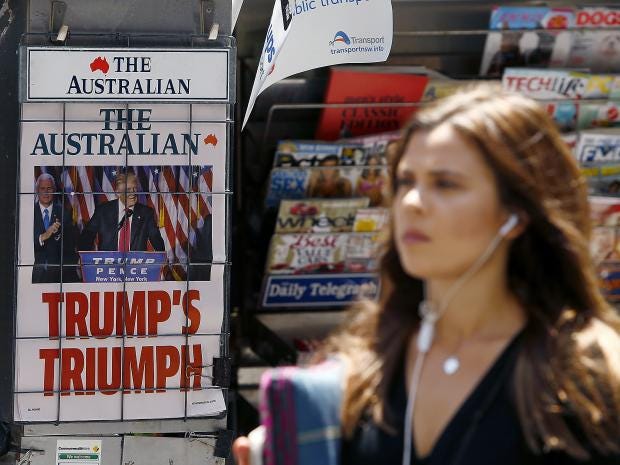Social media echo chambers gifted Donald Trump the presidency
GOOGLE, TWITTER AND FACEBOOK ACCIDENTALLY MADE TRUMP THE PRESIDENT EVEN THOUGH THEY WORKED FOR HILLARY CLINTON

The past few years have seen a seismic shift in public discourse. Amid the furious din of social media, only the most extreme opinions, stripped of nuance, will be heard, while so much of the media has been forced into similarly unsubtle coverage in the face of declining revenues and industry uncertainty.
Back in June 2015, Barack Obama had this to say about the modern political landscape: “The problem is there is this big gap between who we are as a people and how our politics expresses itself. Part of that has to do with…a media that is so splintered now that we’re not in a common conversation. There is a profit, both for politicians and for news outlets, in simplifying and polarising. All those things have combined to make our political institutions detached from how people live on a day-to-day basis.”
His words were prescient. At the end of his presidency, Obama has been on a 54 per cent approval rating, his highest since 2013. The staggering, insidious number of votes for Trump did not come from swing-voting Democrats; they came from a scared, white, male America that felt marginalised. Many felt that their lives were no longer relevant or even visible in the mainstream media.
“When they go low, we go high,” Michelle Obama advised at the DNC, but we didn’t, did we? Whenever we talked about Trump, we used inflammatory language that, while seeming completely fitting for a human being as cruel and selfish as Trump, only served to put fire in the bellies of his supporters. Joss Whedon’s ‘shit ton of celebrities’ declared him “a racist, abusive coward” and one media outlet ran with a headline that called him a “pig” – it was deliberately humiliating, and it only spurred them on. In castigating Trump and his supporters, we drove them to the polling booths and gave the Republicans some of their best state margins in decades. These tactics created an Us vs. Them narrative from which there was no recovery.
“White men over 35 are obsolete,” Michael Moore, who correctly predicted the outcome of the election, said a couple of weeks back, “and that’s why they’re at Trump rallies.”
Instead of trying to reach out and understand why people felt moved to vote for Trump, too many admonished them. We retreated to our echo chambers, where we bellow our opinions at people who are already in agreement and enjoy having them repeated back to us. Our prismatic view of public opinion through tailored social media feeds not only hid from us the confused, angry people we needed to try and reason with, but it gave us a warped view of their motives. And this is where it gets particularly scary:
Trump voters are fully aware he is sexist and xenophobic, they just don’t care.
Many expected the cavalcade of sex abuse scandals that hit Trump to sink him, but this was to assume that they would even bother his ardent supporters. On the contrary, I believe his so-called “locker room talk” actually heartened the kind of person who can’t draw the distinction between genuine cases of overbearing political correctness and harmful, sexist language. It is “safe space” culture that has created this appetite for IDGAF rhetoric. It’s “trigger warnings”. It’s banned Halloween costumes. And it’s not that any of these are wrong per se; it’s that the blanket application of outrage by liberals has driven a certain section of society up the walls, and caused them to accept a lunatic as their leader if it means being able to take a swipe back. They’ve responded with a huge, extraordinary, unprecedented “f*ck you”.
It gives me no pleasure to make this assessment and I shake writing it, but we must confront these harsh realities, which have led to the rise of “shy Tories” and “shy Trump voters” and loosened our grasp on what is really happening and what is really being thought.
This loss of reality was central to Adam Curtis’ excellent recent documentary HyperNormalisation, which, though it was released just before the election, is an effective autopsy of it, charting how we’ve moved into a post-truth world – something which Trump massively exploited throughout his campaign. He consistently operated outside of fact and as such was unassailable; how can you attack a candidate’s views, policies and promises if they just don’t care about them being subjected to scrutiny? If they only care about lying directly to the voter, be it through Facebook Lives or alt-right puppet blogs that look as legit through the window of social media as the broadsheet press?
On this front, vast swathes of the media were effectively neutralised; but much of the snark and hyperbole directed at Trump supporters could have been avoided. We must all take our fair share of the burden of blame.
